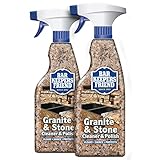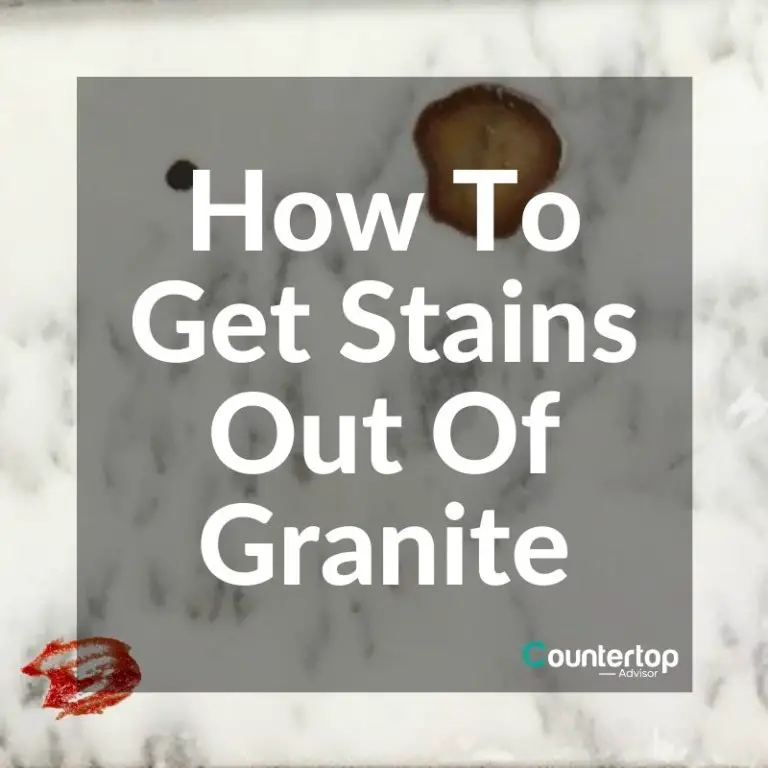How To Get Stains Off Countertops
Granite countertops are naturally stain-resistant. If your granite countertops have been well prepared, and then sealed with a good sealer, the surface will retain most of its stain resistance in the normal course of things. If food, liquids, oil, grease, etc. fall on a granite surface, a quick mop up with paper towels or cloth will usually do the trick as long as the surface is not cracked and has the sealant finish intact. If, however, those materials are left on the surface for a while, stains may start to set in. The trick is to do something about it before it's too late, and the stain sets deep into the granite pores. How you remove stains varies a bit based on what has been spilled on the surface. In this article, we will take you through some step-by-step processes which may work in cases where the stain is not deep-seated, and also what to do when the stain has in fact set in due to a spill being unseen or ignored for a while. Stains affecting granite countertops can be classified under some broad categories, some of which are outlined below: There are a variety of other problems that can occur, including biological stains (e.g. fungus or mildew), fire and smoke damage, ink stains, and/or etchings or markings. We will be discussing the main causes of stains as discussed above. There are well defined fixes, both quick and detailed, as we will go through in the next few sections. As a general rule, the following types of solutions will work: Before we focus on specific actions to take, based on certain popular sources of stains, let's look at some common materials that you should strongly consider stocking for regular cleaning and maintenance, and in some cases to tackle stubborn stains. Below are some cleaning supplies to help you with your granite countertop: Bar Keepers Friend Granite & Stone Cleaner & Polish (25.4 oz) Granite Cleaner for Use on Natural, Manufactured & Polished Stone, Quartz, Silestone, Soapstone, Marble - Countertop Cleaner & Polish (2) Schwarzkopf Igora ROYAL Oil Developer (STYLIST KIT) Hydrogen Peroxide, 33.8 oz / 1000ml (6% / 20 Volume) Sale Iron OUT Powder Rust Stain Remover, Remove and Prevent Rust Stains in Bathrooms, Kitchens, Appliances, Laundry, and Outdoors, white, 4.75 lbs. Rock Doctor Granite & Quartz Care Kit, 3 Piece Maintenance Stone Care Combo Kit – Cleans & Renews Marbel, Travertine, Tile and All Other Stone, Fresh, Pack of 3, 54.0 Ounce Whatever your stain problem, follow the guides below. In general, it is a bad idea to use acidic substances, such as vinegar or ammonia. A number of common household cleaners may have the same problem. pH balanced cleaners, such as the ones listed above, are much more effective and will not damage the surface. Also, using strong detergents mixed with water will often leave a residue that seeps into the pores of the granite, deflecting light and making the surface look dull. Use mild detergents instead. Oil stains can be among the more persistent blemishes on your granite countertops. Sometimes, they sneak up on you unnoticed, especially in the bathroom where cosmetic creams or nail polish spills may be noticed later, and cleaned up less frequently than, say, a cooking oil spill – which will often get wiped off as part of a regular cleaning after the meal. With oily stains, the length of time it sits on the surface is directly correlated with what happens – if cleaned up quickly, the oil has probably not had the chance to sink down through the topcoat or sealer and into the pores of the granite itself. The other thing to remember is that any cleaning action should not inadvertently push the material deeper below the surface, thus compounding the problem. The easiest fix, as always, is to notice the spill immediately. However, as mentioned, you should not be pushing the oily substance deeper down into the granite. Therefore, take care to not wipe, but rather blot, the spilled fluid with a soft sponge or a paper towel. Once the oily residue is removed, use a granite cleaning solution, such as the ones shown above, on the countertop. If the oily residue has remained for a longer time on the countertop, it's possible that it has leaked through to the pores of the material below. To understand where you are, try the first level fixes first. If the stain still sits there, it's time to dig down a level deeper. Unfortunately, you will kill the sealant over the area, but that's better than letting the stain persist. Prepare a paste made of equal parts acetone and baking powder. It should assume the consistency of pancake batter as you cover the stain completely. Do not push it down onto the stain. Alternatively, the paste can be made from a baking powder only, or from a mix of strong hydrogen peroxide, flour, and water. Let the mixture sit on top. You can cover it with plastic wrap (unless you use a commercial paste that tells you not to cover) to let it stay wet and pull more of the oil into the poultice. Ultimately, let the mixture dry out for between 12 to 24 hours. The next day, remove the paste and wash the area down lightly with water. If the stain persists, repeat this process multiple times till the stain is gone. Once done, you will need to reseal the area which you have exposed during this exercise. The following demonstrates different approaches to cleaning oil stains. The first uses a mix of flour and hydrogen peroxide mixed with water, the second uses baking soda and water. and Oil is usually found in liquid form, whereas grease is usually semi-solid. Both of them can arise from animal fat, but oil can also be extracted from plants – such as coconut, soybean, mustard, and a whole roster of cooking and cosmetic oils. In terms of removing stains, however, the methods used to remove oily stains will also work with grease stains. It may be the case that untreated grease stains may tend to be more stubborn, but that simply means that you will need to use the more extensive (poultice driven) means of stain removal. Fingernail polish removal is similar to oil stain removal, with a couple of extra ways to fix the problem quickly. Wax residues are hardened oily substances. If lighting a candle on a granite surface, you must take care to tackle any wax drippings quickly, before too much damage occurs. Wine stains are ones that fall under the organic category, and as such, removing them requires a gentler approach than deep-seated oil stains. Wine glasses or bottles can leave an unsightly ring on your granite surface. Food stains are organic material, and typically can be removed by water, maybe with a little bit of soap or mild detergent. Regular granite cleaning supplies work very well. A more persistent problem may arise with food coloring, which has dyes that could leave more permanent stains on the granite top. However, if stains persist, you may need to go to the next level. You can use one of the following methods to address a deeper stain: Rust stains can accumulate over time, maybe at the edges where nails or other iron fittings are embedded in the granite. When they become noticeable, these brown stains can be persistent unless tackled promptly. The best way to tackle rust stains is to use a product like Iron Out Powder Rust Remover, as shown before. Hard water stains build up over time, leaving mineral deposits and white, powdery residues that stand out against darker granite surfaces. Limescale stains are normal over time, especially in areas around showers, kitchen faucet bases, and other spots where hard water stains may also occur. To get rid of limescale, you need to utilize a combination of steps. Next, you can use one, or both, of the following steps to remove any remaining lime buildup or stains from it: A little care goes a long way towards maintaining your granite countertops, especially ones that have been properly prepared and sealed prior to use. If, however, you find yourself in the position of having to remove unwanted stains that have crept up on you and are now deep-seated, there are multiple ways to remove them and refresh your surfaces. Just be careful to pick the right approach based on what caused the stain in the first place. Our DIY guides above will then allow you to execute the necessary steps without too much trouble. With the right material and approach, you will be able to enjoy having your surfaces retain their gloss and look over the long haul.How to Remove Stains from Granite?
Type of Stain Useful Material for Cleaning - Examples Organic Compounds such as Hydrogen Peroxide (H2O2), choose strength as appropriate (6% or 12%) Oil-Based Poultice compounds, such as (a) baking powder and acetone paste or (b) strong hydrogen peroxide, flour and water Metal Poultice compounds, such as a baking powder and acetone paste Paint Paint strippers made from caustic sodas or lyes Hard Water Dry 0000 steel wool (buffing for normal hard water stain removal) or pH balanced solutions like Granite Gold Daily Cleaner (for limescale) Some Cleaning Materials to Stock




What Not to Use?
How to Remove Oil Stains from Granite
First Level Fixes
How to Tackle Deep Seated Oil Stains
DIY Videos on Cleaning Oil Stains off of Granite Countertops
How to Get Grease Stains Off of Granite
How to Get Fingernail Polish Off of Granite
How to Get Wax Stains Off of Granite
How to Get Wine Stains Out of Granite
DIY Video on Cleaning Wine Stains off of Granite Countertops
How to Clean Food (and Food Coloring) Stains Off of Granite
How to Tackle Deep Seated Food Stains
DIY Video on Cleaning Food Stains off of Granite Countertops
How to Get Rust Stains Off of Granite Surfaces
DIY Video on Cleaning Rust Stains off of Granite
How to Get Hard Water Stains Off of Granite Surfaces
DIY Video on Cleaning Hard Water Stains off of Granite Surfaces
How to Get Lime Buildup Off of Granite Surfaces
DIY Video on Cleaning Limescale and Mineral Deposit Stains off of Granite Surfaces
FINAL THOUGHTS

How To Get Stains Off Countertops
Source: https://countertopadvisor.com/how-to-get-stains-out-of-granite-countertops/
Posted by: olivermeas1955.blogspot.com

0 Response to "How To Get Stains Off Countertops"
Post a Comment